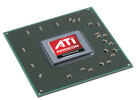Review Alienware M17x (i7/HD 4870 X2) Notebook
Intel Core i7-620M | ATI Mobility Radeon HD 4870 X2 | 17.00" | 5.5 kg

Because of the high amount of shaders (2x800) the gaming performance of the Mobility Radeon HD 4870 X2 is very good and allows the gaming of all DirectX 9 games in high resolutions and details. Even demanding DirectX 10 games of 2008 (i.e., Crysis Warhead and Far Cry 2) can be played with high details. The GPU supports fast GDDR5 graphics RAM, but all laptops as of this writing are built with slower GDDR3 graphics memory (Alienware M17x, Asus).
The 4870 X2 also suffers from micro stuttering most noticeable around 30 fps, similar to all SLI and Crossfire setups. This occurs if both cards are in Alternate Frame Rendering (AFR) Mode since the time delay to display each sequential frame becomes irregular. See our dedicated micro stuttering article here for more information.
The Mobility HD 4870 x2 is based on two RV770 chips and features 2x800 stream processors (2x160 5-dimensional shader cores). These cores do the graphics work of the shader and pixel pipelines of older GPUs. The stream processors are also called ALUs and are grouped in five-way VLIW units. Each of the five instructions of a VLIW bundle has to be independent from the others and the performance therefore depends on the optimization of the driver.
The Mobility Radeon HD 4870 X2 includes Avivo HD, an onboard soundchip for 7.1 sound output over HDMI or DisplayPort and the 2nd generation UVD (Unified Video Decoder). UVD 2 supports full bitstream decoding of H.264/MPEG-4 AVC and VC-1 streams, dual video stream decoding and Picture-in Picture mode which makes the UVD full BD-Live compliant. To put simply, the Avivo HD technology handles all video tasks and enables the GPU to decode HD videos.
AMD published a power consumption of about 2x65 Watt for the HD 4870 X2. Still, it is unclear if this value represents the chip alone or the whole MXM board including the memory, which we estimate would add about 2x5 Watts.
Compared to the desktop ATI Radeon HD 4870 X2, the mobile 4870 X2 features a slower core clock and should therefore perform a bit slower than even the desktop HD 4850 X2.
Mobility Radeon HD 4000 Series
| |||||||
| Codename | M98-XT | ||||||
| Architecture | Terascale 1 | ||||||
| Pipelines | 1600 - unified | ||||||
| Core Speed | 550 MHz | ||||||
| Memory Speed | 888 MHz | ||||||
| Memory Bus Width | 256 Bit | ||||||
| Memory Type | GDDR3, GDDR5 | ||||||
| Max. Amount of Memory | 2048 MB | ||||||
| Shared Memory | no | ||||||
| API | DirectX 10.1, Shader 4.1 | ||||||
| Transistor Count | 1.9 Billion | ||||||
| technology | 55 nm | ||||||
| Features | OpenGL 2.0, PCI-E 2.0 x16, Powerplay, DisplayPort support up to 2560x1600, HDMI support up to 1920x1080 (both with 7.1 AC3 Audio), 1x Dual-Link/Single-Link DVI, 1x Single-Link DVI Support (all display ports have to be supported by the laptop manufacturer) | ||||||
| Notebook Size | large | ||||||
| Date of Announcement | 09.01.2009 | ||||||
| Link to Manufacturer Page | ati.amd.com | ||||||
The following benchmarks stem from our benchmarks of review laptops. The performance depends on the used graphics memory, clock rate, processor, system settings, drivers, and operating systems. So the results don't have to be representative for all laptops with this GPU. For detailed information on the benchmark results, click on the fps number.

| low | med. | high | ultra | QHD | 4K | |
|---|---|---|---|---|---|---|
| CoD Modern Warfare 2 | 84.2 | 59.6 | ||||
| Risen | 60.2 | 31.6 | ||||
| Need for Speed Shift | 52 | 25 | ||||
| Colin McRae: DIRT 2 | 69.7 | 50.4 | ||||
| Anno 1404 | 89.8 | |||||
| Sims 3 | 251.7 | 118.6 | 77.4 | |||
| F.E.A.R. 2 | 105.3 | 92.5 | ||||
| GTA IV - Grand Theft Auto | 48.57 | 32.27 | ||||
| Far Cry 2 | 88.7 | 40.5 | ||||
| Racedriver: GRID | 84.6 | 56.3 | 51.3 | |||
| Call of Duty 4 - Modern Warfare | 156.5 | 106.2 | 99.8 | |||
| Supreme Commander - FA Bench | 52.5 | 51.4 | ||||
| Crysis - GPU Benchmark | 52.4 | 26.7 | ||||
| Crysis - CPU Benchmark | 52.2 | 25.5 | ||||
| low | med. | high | ultra | QHD | 4K | < 30 fps < 60 fps < 120 fps ≥ 120 fps | 1 2 2 | 4 5 | 5 3 | 3 3 2 | | |
For more games that might be playable and a list of all games and graphics cards visit our Gaming List
The Czech website pctuning.cz have already published an extensive review of the Asus W90 with a Intel C2D T9600 and 6 GB RAM. The following gaming benchmarks stem from their review.
Test Drive Unlimited: 1920x1080, high: 47-72 fps -> fluently playable
Bioshock: 1920x1080, high: 67-207 (avg. 131) fps -> fluently playable
Call of Duty 5: 1920x1080, extra: 29-92 (avg. 53) fps -> fluently playable
Crysis Warhead: 1920x1080, Mainstream: 13-45 (avg. 32) fps -> fluently playable (single stutters)
Far Cry 2: 1920x1080, ultra: 21-55 (avg. 33) fps -> fluently playable
Flatout Ultimate Carnage: 1920x1080, high: 36-48 (avg. 43) fps -> fluently playable
Race Driver Grid: 1920x1080, high: 34-56 (avg. 43) fps -> fluently playable
Stalker Clear Sky: 1920x1080, Maximum: 16-39 (avg. 28) fps -> playable
Unreal Tournament 3: 1920x1080, max: 32-63 (avg. 51) fps -> fluently playable
World in Conflict: 1920x1080, high: 19-103 (avg 30) -> playable
Alienware M17x (HD 4870x2): Intel Core i7-620M, 17.00", 5.5 kg
External Review » Alienware M17x (HD 4870x2)
Asus W90Vp: Intel Core 2 Quad Q9000, 18.40", 6.1 kg
External Review » Asus W90Vp
» Comparison of GPUs
Detailed list of all laptop GPUs sorted by class and performance.
» Benchmark List
Sort and restrict laptop GPUs based on performance in synthetic benchmarks.
» Notebook Gaming List
Playable games for each graphics card and their average FPS results.
Top 10 Laptops
Multimedia, Budget Multimedia, Gaming, Budget Gaming, Lightweight Gaming, Business, Budget Office, Workstation, Subnotebooks, Ultrabooks, Chromebooks
under 300 USD/Euros, under 500 USD/Euros, 1,000 USD/Euros, for University Students, Best Displays
Top 10 Smartphones
Smartphones, Phablets, ≤6-inch, Camera Smartphones